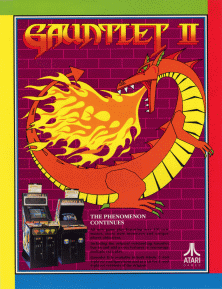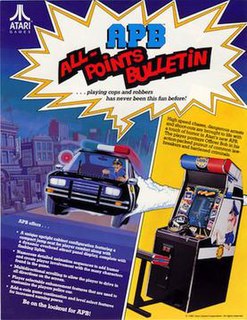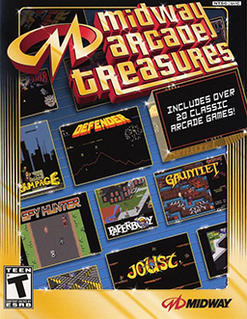
720° is a skateboarding video game released in arcades by Atari Games in 1986, in which the player controls a skateboarder skating around a middle-class neighborhood. By doing jumps and tricks, the player can eventually acquire enough points to compete at a skate park. The game's name comes from the "ultimate" trick, turning a full 720° in the air after jumping off a ramp.

Gauntlet II is a 1986 arcade game produced by Atari Games that serves as the immediate sequel to the original Gauntlet, which was released the previous year. Like its predecessor, Gauntlet II is a fantasy-themed top down dungeon crawler game and was released as a dedicated cabinet, as well as a conversion kit, both available in 2-player and 4-player versions.

Spy Hunter is a vehicular combat action game developed by Bally Midway and released for arcades in 1983. The game draws inspiration from the James Bond films and was originally supposed to carry the James Bond brand. The object of the game is to drive down roads in the technologically advanced "Interceptor" car and destroy various enemy vehicles with a variety of onboard weapons. Spy Hunter was produced in both sit-down and standard upright versions with the latter being more common. The game's controls consist of a steering wheel in the form of a futuristic aircraft-style yoke with several special-purpose buttons, a two-position stick shift, and a pedal used for acceleration.

APB is a video game released in arcades by Atari Games in 1987. The player assumes the role of "Officer Bob," a rookie police officer. As Bob, players drive around the city, ticketing motorists for minor infractions and pulling over more serious offenders. Eventually, players must apprehend criminals for which an all-points bulletin has been called.

Super Sprint is a racing video game released by Atari Games and Midway Games in 1986. Up to three players drive Formula One-like cars on a circuit that is viewed from above. The game is a successor to Gran Trak 10 and the Sprint series, which were black-and-white games from the 1970s. A sequel, Championship Sprint, was released later in the same year.

Midway Arcade Treasures is a video-game compilation of 24 arcade games, emulated from the original PCBs. The overall release was developed by Digital Eclipse and issued by Midway Games for the PlayStation 2, Xbox, GameCube, and Microsoft Windows.

San Francisco Rush 2049 is a racing video game developed and published by Atari Games for arcades. It was ported to the Nintendo 64, Game Boy Color, and Dreamcast by Midway Games. It was released in 2000 on September 7 for North America and November 17 for Europe. It is the third game in the Rush series and the sequel to San Francisco Rush: Extreme Racing and Rush 2: Extreme Racing USA. It is also the last game in the Rush series to be set in the city of San Francisco, and the last released on a Nintendo console. It also serves as the final game for the Atari Games label, which was retired shortly after the arcade release. The Dreamcast version was later re-released as part of Midway Arcade Treasures 3 for the PlayStation 2, Xbox, and GameCube; and later Windows as part of Midway Arcade Treasures Deluxe Edition.
The Lotus series consists of three racing computer games based around the Lotus brand: Lotus Esprit Turbo Challenge, Lotus Turbo Challenge 2, and Lotus III: The Ultimate Challenge. Published between 1990 and 1992 by Gremlin Graphics, the games gained very favourable reviews upon release. Original Amiga versions of the games were created by Shaun Southern and Andrew Morris of Magnetic Fields, and then ported by other individuals to several other computers and game consoles.

Ivan "Ironman" Stewart's Super Off Road is an arcade video game released in 1989 by Leland Corporation. The game was designed and managed by John Morgan who was also lead programmer, and endorsed by professional off-road racer Ivan Stewart. Virgin Games produced several home versions in 1990. In 1991, a home console version for the Nintendo Entertainment System was later released by Leland's Tradewest subsidiary, followed by versions for most major home formats including the Master System, Genesis, Super NES, Amiga, and MS-DOS. A port for the Atari Jaguar was announced but never released. Some of the ports removed Ivan Stewart's name from the title due to licensing issues and are known simply as Super Off Road.

Midway Arcade Treasures 3 is the third and final compilation of classic arcade games published by Midway Games for the GameCube, PlayStation 2, and Xbox. This compilation includes 8 racing games that were not in the 2003 and 2004 releases Midway Arcade Treasures and Midway Arcade Treasures 2. Like the first and second installments, however, the Xbox version is not compatible with the Xbox 360. Unlike the other installments in the Midway Arcade Treasures series, it is rated E for Everyone by the ESRB.

Sprint 2 is a two player overhead-view arcade racing video game released in 1976 by Kee Games, a wholly owned subsidiary of Atari, and distributed by Namco in Japan. While earlier driving games had computer-controlled cars that moved along a "canned predetermined" course, Sprint 2 "introduced the concept of a computer car that had the intelligence to drive itself around the track" in "a semi-intelligent" manner.

Midway Arcade Treasures Deluxe Edition is an arcade compilation released exclusively for the PC on February 17, 2006 in North America, and on March 17, 2006 in PAL regions. It is a compilation of Midway Arcade Treasures 2 and Midway Arcade Treasures 3, which had both been previously released on consoles only. Unlike the previous two volumes, it includes the original Mortal Kombat. In the two months after its release, two official patches were released for the collection, one to fix missing music for half of the games that was accidentally left out of the shipped version, and a second one to correct a button function oversight that prevented Random Select and Smoke battle easter eggs in Mortal Kombat II. A few pieces of additional artwork for Wizard of Wor and Primal Rage were made available as supplements on the Midway website. Like the previous release, the Deluxe Edition's Primal Rage content suffered from emulation issues.

S.T.U.N. Runner is 3D racing/shooter game released in arcades by Atari Games in 1989. The player pilots a futuristic vehicle which can exceed 900 mph, through various tunnels and courses with changing environments, hazards and enemies. S.T.U.N. Runner uses polygonal graphics for the vehicles and track, and is based on an evolution of Atari's Hard Drivin' hardware. The custom cabinet was designed to resemble the craft that the player pilots in-game.

Hard Drivin' is a 1989 driving video game developed by Atari Games. It invites players to test drive a sports car on courses that emphasize stunts and speed. The game features one of the first 3D polygon driving environments via a simulator cabinet with a force feedback steering wheel and using a custom rendering architecture. According to the in-game credit screen, Hard Drivin' was designed by two teams working concurrently in the United States and Ireland.

WEC Le Mans, known as WEC Le Mans 24 in Japan, is a racing simulation video game released in arcades by Konami in 1986. It was the first racing video game to depict the 24 Hours of Le Mans. The Lap of Le Mans is split up into three sections, during which the time of day changes from day to dusk, dusk to night, and night to dawn.

Grand Prix Simulator is a racing game developed by The Oliver Twins and published by Codemasters for the ZX Spectrum, Amstrad CPC, Commodore 64 and Atari 8-bit family. The ZX Spectrum conversion was done by Serge Dosang. The game was endorsed by Ayrton Senna's 1986 Formula One teammate Johnny Dumfries.
Quattro is a series of video game compilations released in the 1990s. They consisted of games developed by Codemasters. The NES versions were released as multicarts and were published by Camerica without a license by Nintendo.

Speed Race is a 1974 arcade racing video game developed and manufactured by Taito, and released under the titles Racer and Wheels in North America by distributor Midway Manufacturing in 1975. Designed by Tomohiro Nishikado, the gameplay involves the player using the attached steering wheel to maneuver a car alongside a fast vertical scrolling road. The objective is to score points by driving past other cars without colliding with them; more points are awarded for driving faster. Players must do this under a 90-second time limit, which ends the game when it runs out. The gameplay concepts were adapted from two earlier driving electro-mechanical games: Kasco's Mini Drive (1958) and Taito's Super Road 7 (1970).

Race Drivin' is a driving arcade game that invites players to test drive several high-powered sports cars on stunt and speed courses. The game is the sequel to 1989's Hard Drivin' and was part of a new generation of games that featured 3D polygon environments. Unlike most racing games of its time, it attempted to model real world car physics in the simulation of the movement of the player's car. Like Hard Drivin', the game is unique among video games in that it includes a true force feedback steering wheel, an ignition key, a four-speed shifter, and three foot pedals: an accelerator, a brake, and a clutch. Released in August 1990, approximately 1200 units were produced at the time of its release for roughly $9000 each.



















